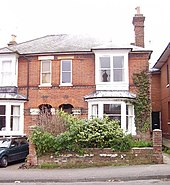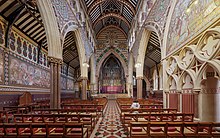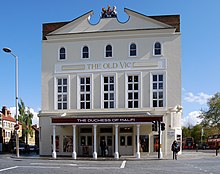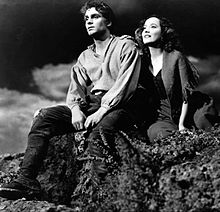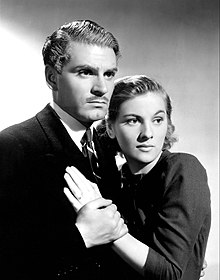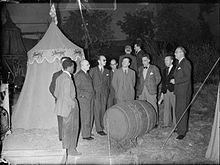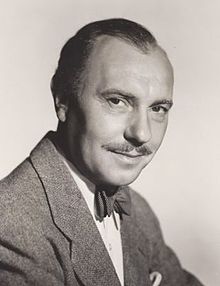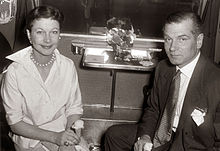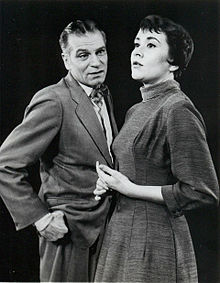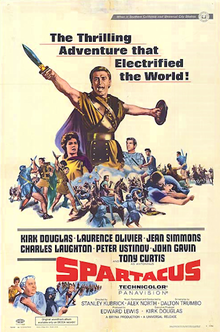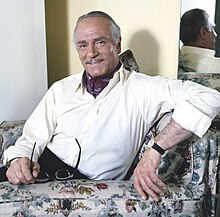Laurence Olivier
His television appearances included an adaptation of The Moon and Sixpence (1960), Long Day's Journey into Night (1973), Love Among the Ruins (1975), Cat on a Hot Tin Roof (1976), Brideshead Revisited (1981) and King Lear (1983).
[15] He made little mark until his final year, when he played Puck in the school's production of A Midsummer Night's Dream; his performance was a tour de force that won him popularity among his fellow pupils.
"[18][d] In 1924 Gerard Olivier, a habitually frugal man, told his son that he must gain not only admission to the Central School of Speech Training and Dramatic Art, but also a scholarship with a bursary to cover his tuition fees and living expenses.
[20][e] One of Olivier's contemporaries at the school was Peggy Ashcroft, who observed he was "rather uncouth in that his sleeves were too short and his hair stood on end but he was intensely lively and great fun".
[23] After leaving the Central School in 1925, Olivier worked for small theatrical companies;[24] his first stage appearance was in a sketch called The Unfailing Instinct at the Brighton Hippodrome in August 1925.
[25][26] Later that year, he was taken on by Sybil Thorndike (the daughter of a friend of Olivier's father) and her husband Lewis Casson as a bit-part player, understudy and assistant stage manager for their London company.
[33] He was offered the part in the West End production the following year, but turned it down in favour of the more glamorous role of Beau Geste in a stage adaptation of P. C. Wren's 1929 novel of the same name.
[59] Olivier's stage roles in 1934 included Bothwell in Gordon Daviot's Queen of Scots, which was only a moderate success for him and for the play, but led to an important engagement for the same management (Bronson Albery) shortly afterwards.
In the interim he had a great success playing a thinly disguised version of the American actor John Barrymore in George S. Kaufman and Edna Ferber's Theatre Royal.
Because of torrential rain the performance had to be moved from the castle courtyard to the ballroom of a local hotel, but the tradition of playing Hamlet at Elsinore was established, and Olivier was followed by, among others, Gielgud (1939), Redgrave (1950), Richard Burton (1954), Christopher Plummer (1964), Derek Jacobi (1979), Kenneth Branagh (1988) and Jude Law (2009).
[92] In late 1938, lured by a salary of $50,000, the actor travelled to Hollywood to take the part of Heathcliff in the 1939 film Wuthering Heights, alongside Merle Oberon and David Niven.
[95] The director, William Wyler, was a hard taskmaster, and Olivier learned to remove what Billington described as "the carapace of theatricality" to which he was prone, replacing it with "a palpable reality".
[129] In Richard III, according to Billington, Olivier's triumph was absolute: "so much so that it became his most frequently imitated performance and one whose supremacy went unchallenged until Antony Sher played the role forty years later".
In the two one-act plays his switch from searing tragedy and horror in the first half to farcical comedy in the second impressed most critics and audience members, though a minority felt that the transformation from Sophocles's bloodily blinded hero to Sheridan's vain and ludicrous Mr Puff "smacked of a quick-change turn in a music hall".
[137] The influential critic James Agate suggested that Olivier used his dazzling stage technique to disguise a lack of feeling, a charge that the actor strongly rejected, but which was often made throughout his later career.
He speaks the lines nobly, and with the caress of one who loves them, but he nullifies his own thesis by never, for a moment, leaving the impression of a man who cannot make up his own mind; here, you feel rather, is an actor-producer-director who, in every circumstance, knows exactly what he wants, and gets it".
[147] Melvyn Bragg in a 1984 study of Olivier, and John Miller in the authorised biography of Richardson, both comment that Esher's action put back the establishment of a National Theatre for at least a decade.
[153][154] Although it was common knowledge that the Old Vic triumvirate had been dismissed,[155] they refused to be drawn on the matter in public, and Olivier even arranged to play a final London season with the company in 1949, as Richard III, Sir Peter Teazle, and Chorus in his own production of Anouilh's Antigone with Leigh in the title role.
[162] Olivier began to notice a change in Leigh's behaviour, and he later recounted that "I would find Vivien sitting on the corner of the bed, wringing her hands and sobbing, in a state of grave distress; I would naturally try desperately to give her some comfort, but for some time she would be inconsolable.
[164] He also recounted the years of problems he had experienced because of Leigh's illness, writing, "throughout her possession by that uncannily evil monster, manic depression, with its deadly ever-tightening spirals, she retained her own individual canniness—an ability to disguise her true mental condition from almost all except me, for whom she could hardly be expected to take the trouble.
It ran for eight months[169] but was widely regarded as a minor contribution to the season, in which other productions included Gielgud in Venice Preserv'd, Coward in The Apple Cart and Ashcroft and Redgrave in Antony and Cleopatra.
Behind Archie's brazen façade there is a deep desolation, and Olivier caught both aspects, switching, in the words of the biographer Anthony Holden, "from a gleefully tacky comic routine to moments of the most wrenching pathos".
The production was chiefly remarkable for the star's quarrels with the director, Orson Welles, who according to the biographer Francis Beckett suffered the "appalling treatment" that Olivier had inflicted on Gielgud at Stratford five years earlier.
[200] The reviewer for The Guardian thought the performances were good, and wrote that Olivier "on the screen as on the stage, achieves the tour de force of bringing Archie Rice ... to life".
While directing Charlton Heston in the 1960 play The Tumbler, Olivier divulged that "Vivien is several thousand miles away, trembling on the edge of a cliff, even when she's sitting quietly in her own drawing room", at a time when she was threatening suicide.
"[218] Dissenting voices included The Sunday Telegraph, which called it "the kind of bad acting of which only a great actor is capable ... near the frontiers of self-parody";[219] the director Jonathan Miller thought it "a condescending view of an Afro Caribbean person".
[240] After this Olivier played three more stage roles: James Tyrone in Eugene O'Neill's Long Day's Journey into Night (1971–72), Antonio in Eduardo de Filippo's Saturday, Sunday, Monday and John Tagg in Trevor Griffiths's The Party (both 1973–74).
In his final speech, over Cordelia's lifeless body, he brings us so close to Lear's sorrow that we can hardly bear to watch, because we have seen the last Shakespearean hero Laurence Olivier will ever play.
[278] In 2007, the centenary of Olivier's birth, a life-sized statue of him was unveiled on the South Bank, outside the National Theatre;[279] the same year the BFI held a retrospective season of his film work.
Like Garrick, Kean, and Irving before him, he lent glamour and excitement to acting so that, in any theatre in the world, an Olivier night raised the level of expectation and sent spectators out into the darkness a little more aware of themselves and having experienced a transcendent touch of ecstasy.
